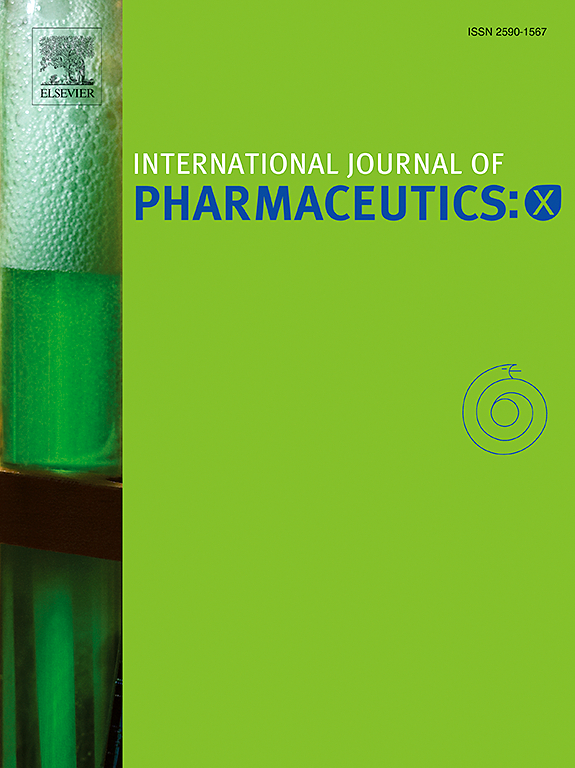Development of 3D printed dexamethasone chewable tablets for prophylaxis of chemotherapy-induced nausea and vomiting in children
IF 6.4
2区 医学
Q1 PHARMACOLOGY & PHARMACY
引用次数: 0
Abstract
Dexamethasone (Dexa) is widely used for the prophylaxis of chemotherapy-induced nausea and vomiting. In pediatric patients, individual dosing often requires the manipulation of commercial tablets, leading to dose inaccuracies, higher treatment complexity and poor acceptance due to Dexa's intensely bitter taste.
This study aimed to develop 3D-printed chewable Dexa tablets with effective taste masking for pediatric oncology. Tablets were produced using semi-solid extrusion (SSE). The impact of excipients on printability and taste masking was evaluated, and the thermal stability of Dexa was assessed using DSC and TGA. Further assessments included disintegration, in vitro dissolution, content and mass uniformity, short-term stability and a sensory evaluation in healthy adult volunteers.
The tablets demonstrated excellent uniformity of mass (average RSD 0.75 %) and API content (99.35 % ± 2.92 %). Disintegration times ranged from 96 s (2 mg) to 733 s (12 mg). Complete drug release was achieved within 2 h. Thermal analysis showed no degradation of Dexa, and storage stability was confirmed for at least 5 weeks. A substantial reduction in bitterness was observed.
In conclusion, SSE enabled the reproducible production of child-appropriate, individually dosed Dexa chewable tablets with effective taste masking, supporting their clinical application in pediatric oncology.

3D打印地塞米松咀嚼片预防儿童化疗引起的恶心和呕吐的研制
地塞米松(Dexa)广泛用于预防化疗引起的恶心和呕吐。在儿科患者中,个体给药往往需要操作市售片剂,导致剂量不准确,治疗复杂性更高,并且由于Dexa的强烈苦味,接受度较差。本研究旨在开发具有有效掩味功能的3d打印可咀嚼Dexa片,用于儿科肿瘤学。采用半固态挤压法制备片剂。通过DSC和TGA对Dexa的热稳定性进行了评价,分析了辅料对印刷性和掩味性的影响。进一步的评估包括崩解、体外溶出度、含量和质量均匀性、短期稳定性和健康成人志愿者的感官评估。质量均匀性好(平均RSD为0.75%),原料药含量为99.35%±2.92%。崩解时间从96 s (2 mg)到733 s (12 mg)不等。药物在2 h内完全释放。热分析显示Dexa没有降解,并且至少5周的储存稳定性得到证实。观察到苦味显著减少。总之,SSE能够重复生产适合儿童的、单独剂量的、有效掩盖味道的Dexa咀嚼片,支持其在儿科肿瘤学中的临床应用。
本文章由计算机程序翻译,如有差异,请以英文原文为准。
求助全文
约1分钟内获得全文
求助全文
来源期刊

International Journal of Pharmaceutics: X
Pharmacology, Toxicology and Pharmaceutics-Pharmaceutical Science
CiteScore
6.60
自引率
0.00%
发文量
32
审稿时长
24 days
期刊介绍:
International Journal of Pharmaceutics: X offers authors with high-quality research who want to publish in a gold open access journal the opportunity to make their work immediately, permanently, and freely accessible.
International Journal of Pharmaceutics: X authors will pay an article publishing charge (APC), have a choice of license options, and retain copyright. Please check the APC here. The journal is indexed in SCOPUS, PUBMED, PMC and DOAJ.
The International Journal of Pharmaceutics is the second most cited journal in the "Pharmacy & Pharmacology" category out of 358 journals, being the true home for pharmaceutical scientists concerned with the physical, chemical and biological properties of devices and delivery systems for drugs, vaccines and biologicals, including their design, manufacture and evaluation. This includes evaluation of the properties of drugs, excipients such as surfactants and polymers and novel materials. The journal has special sections on pharmaceutical nanotechnology and personalized medicines, and publishes research papers, reviews, commentaries and letters to the editor as well as special issues.
 求助内容:
求助内容: 应助结果提醒方式:
应助结果提醒方式:


